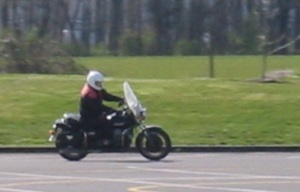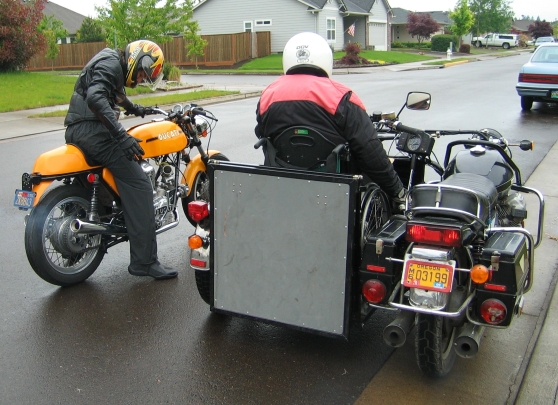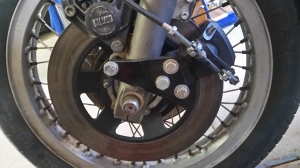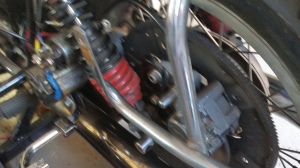Posted Sept. 10, 2015
Even after I was paralyzed from a spinal cord injury I hoped I would be able to ride again. Friends sent me articles about a guy who had designed a set of retractable training wheels and a compressed-air powered shifter, both operated by buttons on the handlebars. Instead of messing with a shifter I bought a Moto Guzzi V1000 Convert, a motorcycle with a torque converter instead of gears. The Convert was basically the Moto Guzzi 850T with the torque converter, a two-speed gearbox (city/country) replacing the 850T’s 5-speed gearbox, and a bigger motor to make up for the power lost from the converter. It had a mildly tuned engine and was part of the Moto Guzzi big twin touring lineup. It came equipped with floorboards, hard bags and a windscreen.
The Convert has been called “Moto Guzzi’s answer to a question nobody asked.” Some think they had their eye on the police market, but it turns out motorcycle cops don’t mind shifting gears. The Convert was never a big seller but it was produced from 1975-1982, a seven-year run. I didn’t mind that it was slow and heavy (well over 500 lbs). It was Italian and I didn’t need to use my foot to shift.
Early one Spring morning in 2002 three of my motorcycle buddies and I took the Convert to a large empty parking lot at the local community college and I rode it around. It was both thrilling and sobering.
 Cruising through the parking lot. Photo by Keith Underdahl.
Cruising through the parking lot. Photo by Keith Underdahl.
Being on two wheels again after three years felt great, but without the use of my torso and leg muscles all my weight was on my hands and wrists. In fact, if I took even one hand off the handle bars I would fall forward onto the gas tank. The parking lot had nice smooth pavement but I imagined how hard it would be riding stiff-armed on rough tarmac. I sadly gave up the idea of riding on two wheels. My injury level was just too high.
Friends also sent some articles on tricycle conversions and on sidecar rigs where the controls had been moved from the motorcycle to the sidecar. I wasn’t too interested in the trikes but the sidecar rig idea had some appeal. There was a company that made and sold rigs commercially, using the Honda CB750A Hondamatic, another torque converter-equipped motorcycle, as the cycle half of the rig. The Hondamatic also failed on the market and was imported only from 1976-1978, and the company closed shop as the supply of CB750A motorcycles dried up.
In fact I saw a lot of photos of those sidecar rigs; just Google “wheelchair sidecar motorcycle” to see many. Most of them had what I felt was a major flaw, however: they had the sidecar on the right. That’s normal in this country and is fine if the pilot is on the cycle. I was going to be piloting from the sidecar and I wanted to be on the side facing on-coming traffic.
I contacted Dauntless Motors Corp., (now going by “DMC Sidecars,” http://www.dmcsidecars.com/) a sidecar retailer and installer near Seattle. They tried to find a British-style sidecar to convert to a left-hand controlled rig but had no luck, so we decided to make one from scratch.
It took a lot longer than I hoped, and the rig was delivered in October, just in time for start of the rains here in Western Oregon. I had time to look it over and there is some clever engineering in it.
 Myself in the rig and Dee’s son Russ on my 1974 Ducati 750 Sport preparing to leave for the Oregon Vintage Motorcyclists’ show in Corvallis. This shows the ramp in the raised position. Photo by Dee.
Myself in the rig and Dee’s son Russ on my 1974 Ducati 750 Sport preparing to leave for the Oregon Vintage Motorcyclists’ show in Corvallis. This shows the ramp in the raised position. Photo by Dee.
Clutch Lever Relocation – the Convert does have a clutch that is used to shift between the two gears, but instead of leaving the lever on the left handlebar it was moved to a short bar just behind the motorcycle’s left floorboard. When I’m in position in the chair I can reach down with my right hand, squeeze the lever and push or pull the bar to change gears. The two gears are intended to be town and country, but it seems to work OK in either setting in either gear. There’s no tachometer so I can’t really tell the difference in RPM.
The Parking Brake – the Convert has no neutral; it’s always in gear. Dauntless installed a small cable-operated disk brake that grips one of the front disks. I pull back on a lever in the sidecar to activate the brake, and push a button on the top of the lever to release it. With the brake I can pause for a short time without shutting the motor off.
 The cable-operated disk brake is clamped to the left fork lower, mounted behind the fork leg.
The cable-operated disk brake is clamped to the left fork lower, mounted behind the fork leg.
The Loading Ramp – it’s a folding ramp that is raised or lowered via a wire cable operated by a small electric-powered winch. Operation is by two buttons mounted at the front left corner of the sidecar frame. There is one flaw, however. There is no sensor that stops the winch when the ramp is fully raised. I have to watch to make sure I don’t over-stretch the cable. In the raised position the ramp also provides a backstop to prevent me from rolling backwards off the sidecar.
Reverse “Gear” – The Convert has no reverse gear, but there are times I need to back the rig up, and I’m not going to hop out, push the thing backwards, then hop back in and drive off. The Dauntless folks solved that by putting a sprocket on the rear wheel and installing a car starter motor inside the left pannier. It’s not quite the same as having an actual reverse since it’s not controlled by the throttle. It has only one speed, controlled by a button on the handlebar.
 The car starter motor can be seen just in front of the rear shock — the blue cable goes to the solenoid. The large sprocket is mounted inside of the rear disk. The starter motor is covered when the rear pannier is in place.
The car starter motor can be seen just in front of the rear shock — the blue cable goes to the solenoid. The large sprocket is mounted inside of the rear disk. The starter motor is covered when the rear pannier is in place.
Three Wheel Brakes – there is actually four disk brakes on the rig, the normal three on the motorcycle and a fourth on the sidecar wheel. The Convert had the Moto Guzzi linked brake system where pressing on the foot pedal activated one of the front disk brakes and the rear brake, with an adjustable proportion valve. The brake lever on the right handle bar connected to the second front disk. The rig is set up with two linked systems. Squeezing the right handlebar activates one of the front disk calipers and the one on the sidecar wheel, while the left handlebar lever activates the second front disk and the rear disk. As long as both levers are used you don’t get the awkward chair steering effect, where under braking the motorcycle slows but the chair keeps going, sending rigs with right-side chairs off to the left.
Passenger Accommodation – The passenger sits on the motorcycle seat, of course, but there’s no longer a set of handlebars to hold onto. Dauntless rigged up a bar that is bolted to the engine guard. You can see the bar in the large photo above.
“Enough of all this technical stuff, what’s it like to ride?” you ask. Well, it’s different. When turning on a motorcycle there’s a progression. As you lean in at first you’re making a wide turn. As you lean more the bike turns tighter as you negotiate the turn. Then, as you lift the bike back to vertical, the turn widens again. The sidecar doesn’t lean and when I turn the handlebars the rig turns RIGHT NOW. With me sitting in the sidecar instead of on the motorcycle seat the thing is very stable and balanced compared to a conventional sidecar rig. There’s no worry about lifting the sidecar in tight turns. When Barry, the engineer from Dauntless, delivered the rig he said “it handles like a little slot car.” He did admit that he was able to lift the sidecar once, but he had to try really hard.
So it doesn’t handle like a motorcycle, no surprise there, but the “wind in the hair” feeling is nearly the same. Like on a motorcycle I am in the environment I’m riding through, and I can feel shifts in the wind, changes in smells, the temperature rise and fall. I rode it a fair amount the summer after it was delivered, then some electrical problems sidelined it for the next season. Then I got busy with other “stuff,” but I’m actively working on it now. It looks like I’ll miss this riding season but I hope to have it ready for the next one.